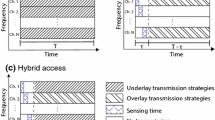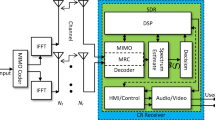Abstract
Many efforts have been dedicated to cognitive radio research and many schemes have been proposed for cognitive radio in the past few years. Unfortunately, an important piece of cognitive radio, namely, signal separation, is missing. The goal of this paper is to stimulate the research interests of incorporating signal separation into cognitive radio. This paper will argue that the signal separation component is not only critical but also feasible. We starts with an integrated view of cognitive radio and software radio architecture, and then a physical layer architecture based on blind signal separation is examined. It will be shown that the signal separation component can serve for many purposes, including separating different kinds of signals and performing multiuser detection. The performance is evaluated by computer simulations and the feasibility is discussed through complexity analysis.














Similar content being viewed by others
Notes
Here we consider both WiMax and Bluetooth are primary users with some other secondary users co-exist with them.
If one wants to further recognize the separated signals, signal recognition must be performed.
Generally speaking, division could be four times as complex as multiplication, but here we consider an advanced architecture such as the one mentioned in [42].
These numbers are based on experiments.
This is not always true but for simplicity we make this assumption and the scaling can be later applied to make it reflect the real processor cycles.
References
Cabric, D., O’Donnell, I. D., Chen, M.S.-W., & Brodersen, R. W. (2006). Spectrum sharing radios. IEEE Circuits and Systems Magazine, 6(2), 30–45.
Akyildiz, I. F., Lee, W. Y., Vuran, M. C., & Mohanty, S. (2006). Next generation/dynamic spectrum access/cognitive radio wireless networks: A survey. Computer Networks Journal, 50, 2127–2159.
Reed, J. H. (2002). Software radio: A modern approach to radio engineering. Prentice Hall Communications Engineering and Emerging Technologies Series. Englewood Cliffs: Prentice Hall.
Haykin, S. (2005). Cognitive radio: Brain-empowered wireless communications. IEEE Journal on Selected Areas in Communications, 23(2), 201–220.
Dhawan, S. (2007). Analogy of promising wireless technologies on different frequencies: Bluetooth, WiFi, and WiMAX. In Proceedings of the 2nd international conference on wireless broadband and ultra wideband communications (AusWireless) (pp. 14–22), 27–30 August 2007.
Gastedo, L., Escudero, C. J., & Dapena, A. (1997). A blind signal separation method for multiuser communications. IEEE Transactions on Signal Processing, 45(5), 1343–1348.
Sarperi, L., Nandi, A. K., & Zhu, X. (2004). Multiuser detection and channel estimation in MIMO OFDM systems via blind source separation. In Proceedings of 5th international symposium on independent component analysis and blind signal separation (ICA) (pp. 1189–1196), 22–24 September 2004.
Kohno, R. (2000). Structures and theories of software antennas for software defined radio. IEICE Transactions on Communications, E83-B(6), 1189–1199.
Kohno, R. (2002). Signal processing and ASIC’s for ITS telecommunications—spread spectrum, array antenna and software defined radio for ITS. IEICE Transactions on Fundamentals, E85-A(3), 566–572.
Ikemoto, K., & Kohno, R. (2002). Adaptive channel coding techniques using finite state machine for software defined radio. IEICE Transactions on Communications, E85-B(12), 2663–2671.
Morelos-Zaragona, R., Haruyama, S., Abe, M., Sasho, N., Michael, L. B., & Kohno, R. (2002). A software radio receiver with direct conversion and its digital processing. IEICE Transactions on Communications, E85-B(12), 2741–2749.
Zhao, Q., Tong, L., Swami, A., & Chen, Y. (2007). Decentralized cognitive MAC for opportunistic spectrum access in ad hoc networks: A POMDP framework. IEEE Journal on Selected Areas in Communications, 25(3), 589–600.
Wang, F., Krunz, M., & Cui, S. (2008). Price-based spectrum management in cognitive radio networks. IEEE Journal of Selected Topics in Signal Processing, 2(1), 74–87.
Pawelczak, P., Pollin, S., So, H.-S. W., Bahai, A., Prasad, R. V., & Hekmat, R. (2008). Quality of service assessment of opportunistic spectrum access: A medium access control approach. IEEE Wireless Communications, 46(10), 20–29.
Lee, C.-H., & Wolf, W. (2007). Design methodology of software radio systems. Embedded Computer Systems: Architectures, Modeling, and Simulation, 4599/2007, 355–364.
Newman, T. R., Barker, B. A., Wyglinski, A. M., Agah, A., Evans, J. B., & Minden, G. J. (2007). Cognitive engine implementation for wireless multicarrier transceivers. Wireless Communications & Mobile Computing, 7(9), 1129–1142.
Yarkan, S., & Arslan, H. (2008). Exploiting location awareness toward improved wireless system design in cognitive radio. IEEE Communications Magazine, 46(1), 128–136.
Buehrer, R. M., Correal-Mendoza, N. S., & Woerner, B. D. (2000). A simulation comparison of multiuser receivers for cellular CDMA. IEEE Transactions on Vehicular Technology, 49(4), 1065–1085.
Zhou, J., & Thompson, J. (2008). Linear precoding for the downlink of multiple input single output coexisting wireless systems. IET Communications, 2(6), 742–752.
Islam, H., Liang, Y.-C., & Tuan, H. A. (2008). Joint power control and beamforming for cognitive radio networks. IEEE Transactions on Wireless Communications, 7(7), 2415–2419.
Gardner, W. A. (1988). Signal interception: A unifying theoretical framework for feature detection. IEEE Transactions on Communications, 36(8), 897–906.
Ghasemi, A., & Sousa, E. S. (2005). Collaborative spectrum sensing for opportunistic access in fading environments. In Proceedings of first IEEE international symposium on new frontiers in dynamic spectrum access networks (DySPAN) (pp. 131–136).
Caamano, A. J., Boloix-Tortosa, R., Ramos, J., & Murillo-Fuentes, J. J. (2004). Hybrid higher-order statistics learning in multiuser detection. IEEE Transactions on Systems, Man, and Cybernetics- Part C: Applications and Reviews, 34(4), 417–424.
Mendel, J. M. (1991). Tutorial on higher-order statistics (spectra) in signal processing and system theory: Theoretical results and some applications. Proceedings of the IEEE, 79(3), 278–305.
Razavilar, J., Rashid-Farrokhi, F., & Liu, K. J. R. (1999). Software radio architecture with smart antennas: A tutorial on algorithms and complexity. IEEE Journal on Selected Areas in Communications, 17(4), 662–676.
Amari, S., & Cichocki, A. (1998). Adaptive blind signal processing—neural network approaches. Proceedings of the IEEE, 86(10), 2026–2048.
Hyvarinen, A. (1999). Fast and robust fixed-point algorithms for independent component analysis. IEEE Transactions on Neural Networks, 10(3), 626–634.
Joutsensalo, J., & Ristaniemi, T. (1998). Learning algorithms for blind multiuser detection in CDMA downlink. In Proceedings of the ninth IEEE international symposium on personal, indoor and mobile radio communications (Vol. 3, pp. 1040–1044), 8–11 September 1998.
Gupta, M., & Santhanam, B. (2004). Prior ICA based blind multiuser detection in DS-CDMA systems. In Proceedings of the thirty-eighth asilomar conference on signals, systems and computers (Vol. 2, pp. 2155–2159), 7–10 November 2004.
Fang, Y., & Takaya, K. (2007). An application of ICA to DS-CDMA detection. In Proceedings of Canadian conference on electrical and computer engineering (CCECE) (pp. 609–612), 22–26 April 2007.
Leong, W. Y., & Homer, J. (2006). Blind multiuser receiver for DS-CDMA wireless system. IEE Proceedings on Communications, 153(5), 733–739.
El-Khamy, S. E., & Abed, M. (2006). Performance enhancement of downlink multiuser DS-CDMA detectors using processing by independent component analysis. In Proceedings of the 2006 international conference on computer engineering and systems (pp. 237–243), 5–7 November 2006.
Chen, J., Zhu, X., & Zhang, X. (2003). A multiuser detector based on blind signal separation. In Proceedings of international conference on communication technology (ICCT) (Vol. 2, pp. 1809–1812), 9–11 April 2003.
Murillo-Fuentes, J. J., Sanchez-Fernandez, M., Caamano-Fernandez, A., & Gonzalez-Serrano, F. J. (2001). Adaptive blind joint source-phase separation in digital communications. In Proceeding of IEEE international conference on communications (ICC) (Vol. 3, pp. 930–934), 11–14 June 2001.
Waheed, K., & Salem, F. M. (2005). Blind information-theoretic multiuser detection algorithms for DS-CDMA and WCDMA downlink systems. IEEE Transactions on Neural Networks, 16(4), 937–948.
Ristaniemi, T., & Joutsensalo, J. (2002). Advanced ICA-based receivers for block fading DS-CDMA channels. Signal Processing, 82(3), 417–431.
Peng, C.-H., Chi, C.-Y., & Chang, C.-W. (2006). Blind multiuser detection by kurtosis maximization for asynchronous multirate DS/CDMA systems. EURASIP Journal on Applied Signal Processing, 2006, 1–17.
Iglesia, D., Dapena, A., & Escudero, C. J. (2003). Multiuser detection in MIMO OFDM systems using blind source separation. In Proceedings of sixth Baiona workshop on signal processing in communications (WSPC) (pp. 41–46). Baiona, Spain.
Guo, B., Lin, H., & Yamashita, K. (2004). Blind signal recovery in multiuser MIMO-OFDM system. In Proceedings of the 47th IEEE international midwest symposium on circuits and systems (MWSCAS) (Vol. 2, pp. II-637-II-640), 25–28 July 2004.
Sawada, H., Mukai, R., Araki, S., & Makino, S. (2004). A robust and precise method for solving the permutation problem of frequency-domain blind source separation. IEEE Transactions on Speech and Audio Processing, 12(5), 530–538.
Lee, C.-H., & Wolf, W. (2006). Architectures and platforms of software (defined) radio systems. International Journal of Computers and Their Applications, 13(3), 106–117.
Venkat, K. (2006). Efficient modulation and division using msp430. http://focus.ti.com/lit/an/slaa329/slaa329.pdf.
Acknowledgements
This work was supported by the National Science Foundation under grant 0509463. We would like to thank the reviewers for their useful comments to help improve the quality of this paper.
Author information
Authors and Affiliations
Corresponding author
Rights and permissions
About this article
Cite this article
Lee, Ch., Wolf, W. Blind Signal Separation for Cognitive Radio. J Sign Process Syst 63, 67–81 (2011). https://doi.org/10.1007/s11265-009-0400-1
Received:
Revised:
Accepted:
Published:
Issue Date:
DOI: https://doi.org/10.1007/s11265-009-0400-1




